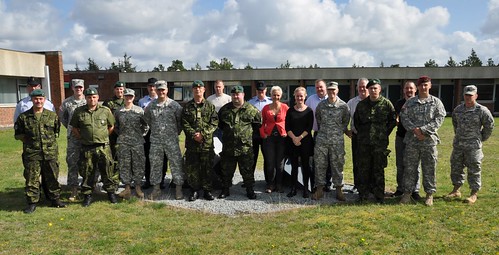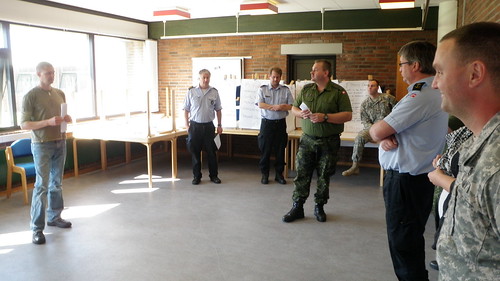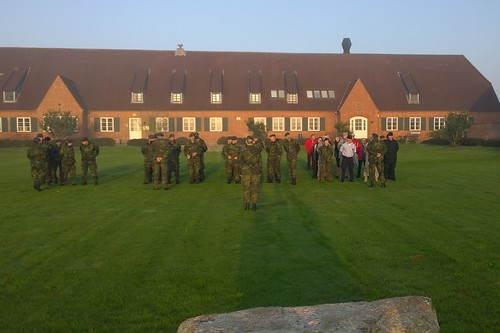Commentary by Capt. James Schmitz, 577th Engineer Company
[caption id="" align="aligncenter" width="500"]

Class photo of the 2014 Military Reserve Exchange Program in Nymindegab, Denmark, including Kentucky Guardsman, Capt. James Schmitz (6th from right). (Courtesy photo)
NYMINDEGAB, Denmark -- Annually, the United States Army participates in the Military Reserve Exchange Program, which partners U.S. Soldiers from the reserve components of Great Britain, Germany and Denmark. Soldiers participate in field exercises or attended courses overseas for up to three weeks. This year, I was fortunate enough to attend the Danish Home Guard Leadership Course, a week long class for small unit leaders of all three branches of the Danish Home Guard.
According to the U.S. Army, the primary purpose of the program is to provide National Guard and Reserve officers training associated with mobilization duties while enhancing their ability to work and communicate with the military individuals of the host nation.
The program allows a unique opportunity to witness the contrast of other countries' military operations. But regardless of those differences, the dedication of serving their country remains the same.
[caption id="" align="alignright" width="400"]

Particpants in the 2014 Military Reserve Exchange Program hold a group discussion in Nymindegab, Denmark. (Courtesy photo)
In Denmark the Home Guard is an all-volunteer, unpaid force that supports the country’s active military, police, and customs services. They are split into the Army, Air Force, and Naval Home Guard. The Army is further separated into Police, Reconnaissance, and Infrastructure Guard units. Members from each of the branches were present in the 18 person class, which included six Americans from across the country.
The course itself covered basic leadership concepts such as effective communication, problem solving, human motivation, and group dynamics. These are basic concepts that I’ve seen in many courses from the old Primary Leadership Development Course through ROTC and other college level leadership courses, but the way they presented the material was extremely effective. Things are kept deliberately ambiguous to force you to think about what you are learning and why it’s important. Personality conflicts and how to work through them are a major part of the course, and the groups we worked in were designed to facilitate that.
Instead of the typical PowerPoint-heavy class, there was a big emphasis on individual and small group learning, which was then shared with the entire class to reinforce common themes and highlight differences caused by the different makeups of each group. Outside of class, there were great opportunities to talk to each other and build some cultural understanding over meals and the occasional off-duty beverage in the Officers’ Club.
One of the biggest questions we had was ‘How do you maintain an unpaid force?’ The benefits we give to National Guard members to assist in recruiting, like helping with college expenses and healthcare, are already built into their social system, so they can really focus on people who are willing to serve.
Reminders of why the Home Guard is needed are easy to find at the Home Guard School, located in the coastal town of Nymindegab. Built by the Nazis during World War II, the buildings were a military outpost that served as part of Hitler’s Atlantic Wall. Concrete pillboxes, coastal fortifications, overgrown trenches, and ammunition bunkers litter the small compound.
You could see by the construction methods they used that they built this place with the intention of still being here today. These are solid brick buildings, very different than either the wooden WWII barracks we built or the hasty construction in Iraq or Afghanistan.
[caption id="" align="alignleft" width="374"]

Morning formation of participants in the 2014 Military Reserve Exchange Program in Nymindegab, Denmark. (Courtesy photo)
Despite that history, the two nations are now both members of the European Union and German tourism is a staple of the western Danish economy.
One major difference between the Danish Home Guard and the U.S. forces is the role rank plays. The leadership course included ranks from private to sergeant first class to captain, but especially in the Naval Guard, the commander of a ship may actually be the lowest ranking individual aboard.
There is a much bigger emphasis on building consensus in their culture. Platoons of the Home Guard have deployed to Afghanistan and Kosovo to perform force protection duties, but because they do not typically have the direct combat missions that the U.S. reserve forces perform, most Home Guard members are only required to perform 24 hours of training a year to maintain their status. Many of the people I met perform hundreds of hours each year, which speaks to their level of commitment.
Anytime you get to travel overseas, work with a new group, and learn about a new culture is a great opportunity. This program runs every year and there are lots of spots available, so I’d encourage Soldiers to apply for this.